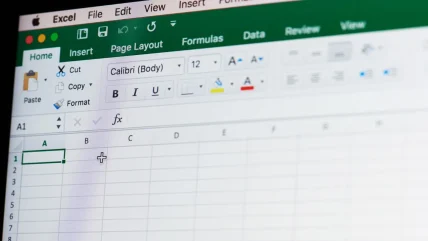
“The vast majority of companies we come across are using spreadsheets, whiteboards, and paper-based files to try and manage their fleets of vehicles.” That is Jim Finnegan, CEO of relatively new fleet software specialist Pocket Box, discussing what is really not a new problem.
While big fleets – especially those with complex and/or regulated commercial vehicles – are likely to be using a more sophisticated system, the SME sector is known for its penchant for managing vehicles with Excel. We have even heard, anecdotally, of some companies using Word for the same purpose.
That is not a criticism. You cannot blame organisations with limited buying power, expertise, and resources for using such software for managerial tasks. Fleet managers in such organisations are unlikely to bear that job title, because looking after vehicles will probably be one of numerous responsibilities.
Defaulting to spreadsheets is more a reflection of the realities facing such businesses than a deliberate decision not to employ IT that is better up to the task – either that, or they may simply be unaware of the alternatives – but whatever way you look at it, Microsoft’s 365 Office suite is not the best way to administer vehicles and drivers.
Pocket Box estimates that around 80% of the fleets it works with were previously using the three methods Finnegan described in his opening quote to manage vehicles. Fleetcheck’s MD, Peter Golding – a long-time proponent of ditching spreadsheets, who has formerly described Excel as his biggest competitor – thinks it is more like 90%.
“I often make a comparison with accountancy software,” he says, “nowadays, in the UK, it is mandated that you have to submit your tax returns to HMRC through software, so 20 years ago, we were looking at computerising and modernising the way that accounts were done. And let’s be honest, we still employ bookkeepers – but they don’t write things in books anymore. In a way, I think the fleet market is probably around 10/15 years behind where we are with accountancy software.”
In February, Fleetcheck made a basic version of its vehicle inspection app available for free. Known as Driverlite, it is essentially a checklist for drivers to ensure that they and their vehicles are fit to hit the road before they do. The paid-for version of the app launched in 2017 and is said to have processed 20 million checks, and while the no-cost equivalent is not a substitute for a pukka management system, it is designed as a first step for those unfamiliar with fleet-specific software or apps.
Golding, who readily admits the move was a commercial decision to expose more businesses to the company, explains the other motives behind launching a basic free service.
“We introduced this primarily for people who are perhaps a little bit, ‘is this going to work? How do we know the drivers are going to like it?’ We know from experience that it does work, but it gives them a chance to stick their toe in the water. [and] it makes sense for us to be at the forefront of trying to help more and more companies adopt the technology.”
It might have been considered something of a novelty in the previous decade but, these days, it is not at all difficult to find a fleet software company offering a driver check app (the frequency of press releases we at Business Car receive announcing such products suggests they are now very much commonplace). Most provide a similar service to Driverlite – guiding drivers through a series of checks to ensure roadworthiness before they set off. There is also a big focus on the paperless element and that drivers do not need to physically hand in documents for processing, which skirts the risk of them getting lost or messed up, saves printing, admin, and all the other associated benefits. Factor in all the above, and we would suggest that SMEs moving from spreadsheet-style vehicle management to dedicated fleet software could reasonably expect a driver inspection app as a minimum.
The other big problem with spreadsheets is that, while they are good at storing information, they are not so hot when it comes to prompts. Devil’s advocate: it is apparently possible to set up date-based email reminders in Excel using a function called Power Automate, so those dead set on sticking with it could make their own alerts for, say, regular driving licence checks. That would take a fair bit of setting up, though, and as Finnegan explains, one of the main reasons for a proper software system is that it does those sorts of things for you and stashes everything in one place.
“[It] automates a lot of the jobs,” he says, “tax, insurance, MOTs, if they have dealer finance, service histories, all their daily vehicle walkaround checks – and that covers the company for compliance and risk.
“You can store all your documents in one safe place. so any policy renewals, anything driver related, it’ll automatically tell the fleet manager in time to make sure that they can action it and make sure the vehicles are legal. and you can’t really do that from an Excel spreadsheet.”
Pocket Box, which specialises in SMEs, estimates that less than 5% of fleets it speaks to are aware of their legal responsibilities and, when they dig into the detail, typically discover that more than 25% of their vehicles are not road legal.
“What ends up happening is, it [fleet management] is a secondary job, and because they’re manually entering MOTs and all that stuff, they forget. They just don’t update it. Maybe the dates are wrong, somebody makes a mistake, or somebody’s left the firm, it’s handed on to another person and it’s just not done. We pull in a live feed from the DVLA on MOT and tax. and a lot of the time, we find companies that maybe have no MOTs or no tax on their vehicles.”
It would hardly be the first time that Business Car has addressed this topic around fleet management, but responsibility for a vehicle’s roadworthiness ultimately lies with the company. Even grey fleets, where the vehicle belongs to the employee, should be subject to basic safety and compliance checks, with legal minimum tyre tread, MOT certificates, road tax, business insurance, and general fitness for purpose as bare minimums – along with regular licence checks for the driver.
This is a subject we find ourselves returning to again and again, and while a small business with a diligent Excel whizz could theoretically stay on top of all that, anecdotal evidence suggests such a scenario would be pretty rare.
As a point of comparison, Microsoft 365 Business ranged from £4.90 per user per month for the Basic package to £18.10 for Premium at the time of writing. Fleetcheck’s entry-level Driver package was £2 per vehicle per month with a minimum spend of £20 per month, topping out at £8/minimum £80 for the top-end Expert version (all excluding VAT). Put simply, it is a case of the right tool for the job.
The latest from the software giants
Jumping ship from haphazard spreadsheets might be the aim of the game for SMEs and the software firms that serve them, but it is also worth a look at the latest developments from the sector’s bigger organisations for large fleets and leasing companies.
Long renowned as the industry’s go-to SMR management guru, Epyx announced an update to its 1link Disposal Network remarketing platform in March. Known as Multi-Channel Remarketing, it essentially gives users more control over how and where vehicles are sold and at what price. As an example, it said fleets could place a vehicle in a trade and a retail channel at the same time, at different prices.
“The Multi-Channel Remarketing tool adds several layers of sophistication to [the existing platform], providing a genuinely granular level of management,” says chief commercial officer, Tim Meadows, “whether a fleet is disposing of a hundred identical vehicles or a single car, van, or truck, it enables them to ensure that that the remarketing strategy adopted has the best possible chance of maximising its value.
“We’ve been through a quite long period when fleets have habitually achieved strong returns because of a combination of reduced supply and increased demand. Now, we are returning to something that more closely resembles the pre-pandemic market, and those in charge of disposal are having to be much more proactive.”
Elsewhere, Webfleet launched what it claimed was the world’s first EV services platform at the CES technology show in Las Vegas, in January. It is said to merge tools from mobility and energy companies within one piece of software, with the aim of helping fleets handle all of the following under one digital roof: charging hardware and software, smart charging, energy management, battery analytics, planning and ordering, and general fleet management.
“A fleet manager can, for example, get range information to allocate the most suitable vehicle to get a specific job done,” says Taco Olthoff, EV program director at Webfleet’s parent company, Bridgestone Mobility Solutions, “this trip information can then be shared with their charging management provider to select which vehicle should be charged and when based on the required battery level and trip schedule.”





